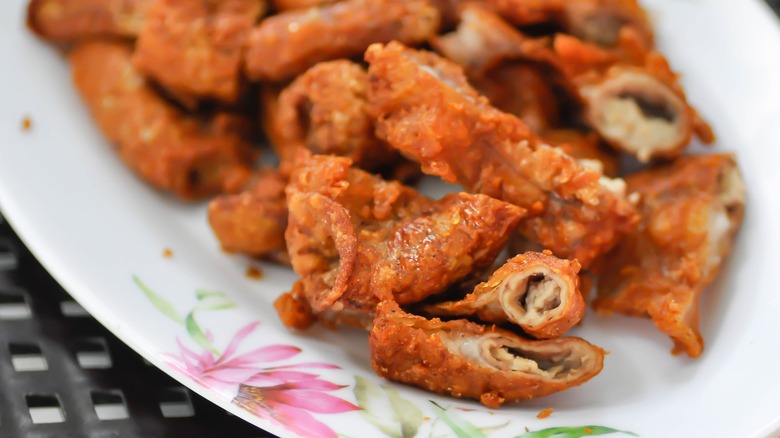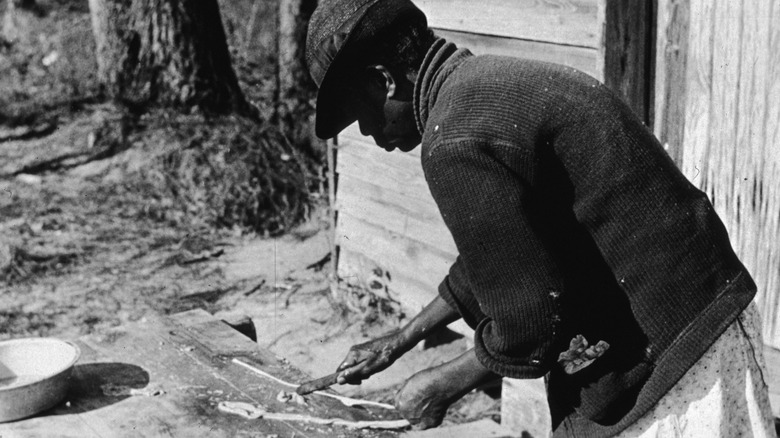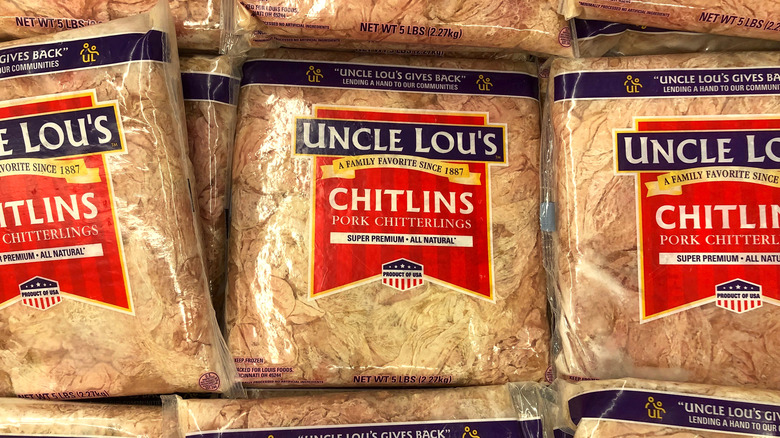The Important History Behind Chitlins
Haggis, foie gras, tripe — you've surely heard of these global delicacies, all made using animal organs, otherwise known as "offal." But there's another dish that follows the mantra of using every last part of an animal, and its origins tell an important story about the Southern region of the United States: chitlins.
Also known as chitterlings, chitlins are boiled or fried pig intestines cooked with onions and seasonings, and served with hot sauce and apple cider vinegar. Versions of it exist all over the world, and these fried-intestine treats have quite a variety of reputations — in the Middle Ages in some parts of Europe, they were considered a food for commoners, whereas in France, andouillette was treated as a delicacy.
The place of chitlins in Southern soul food likely began in the pre-Civil War era, when slave owners would have first pick of the better cuts of the pig, before the scraps, including the pig feet and intestines, were given to enslaved people to cook and eat for themselves. They learned how to turn what they had into delicious meals that became Southern mainstays, demonstrating their talent and resourcefulness in the kitchen — as well as their knowledge of making challenging foods safe to eat.
Chitlins have a mixed reputation in the modern age
Today, there are mixed opinions on chitlins. Some African American people feel that chitlins are a reminder of the scarcity and injustice their ancestors were forced to live through, while others see them as a reminder of their ancestors' resourcefulness, strength, and survival. To some, chitlins became a traditional meal only because it had to be one, with limited resources offering limited cooking options for enslaved people. Now, with everyone having the freedom to pick whichever cut of the pig they want, many prefer not to continue using what was once considered the scraps of the animal.
Still, others believe continuing to prepare these traditional meals is a way of reclaiming their culture. Chitlins are considered to be "soul food," a term that was popularized during the civil rights movement in the 1960s as a way to recognize and celebrate the distinct impact of African Americans on the culinary landscape of the U.S. Today, there are soul food restaurants in nearly every major U.S. city serving mac and cheese, shrimp and grits, peach cobbler, and other dishes that are thought of by many Americans today as classic, comforting staples even outside the South. As for chitlins? They're now most commonly served at holidays and other large family gatherings as a special treat.
Cooking (and eating) chitlins
Because they're a piece of a pig's digestive tract, an extremely thorough cleaning process is necessary to avoid contracting yersiniosis or other foodborne illnesses. And be forewarned — they also smell, well, exactly how you'd expect a pig's intestine to smell. But as long as you're careful, there's a way to safely clean and prepare them.
You should always be cautious of foodborne illness when working with raw meat, making sure to sanitize any countertops or cutting boards that come in contact with the meat and switching out utensils to avoid cross contamination. All pork products run the risk of being infected with Yersinia, a bacterium that can spread not only through consumption, but also by touch, and can cause fever and abdominal pain. So when cleaning raw chitlins, take extra care to wash your hands after touching them, deep-clean any surfaces they're on, and have children leave the room during the cleaning process to avoid them touching an unclean surface.
Once you've prepared your area, the best way to thoroughly clean chitlins includes boiling them to kill the bacteria, picking debris, straw, and feces off each piece by hand, separating a thin layer of fat from the chitlin, and even more careful steps. The fried, crunchy classic is often paired with spicy hot sauce and tangy vinegar and is accompanied by other traditional soul food dishes like collard greens and cornbread.


